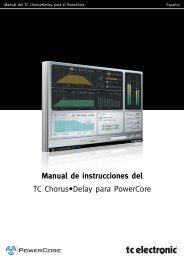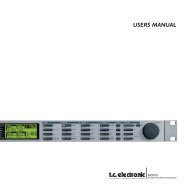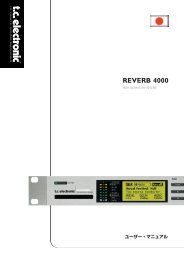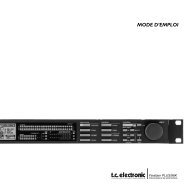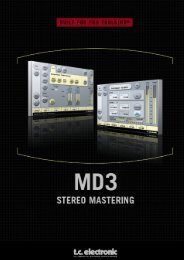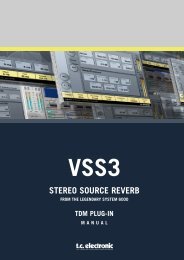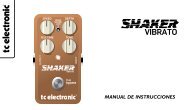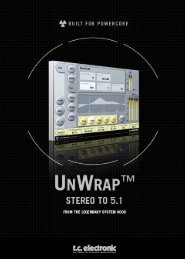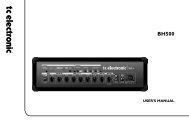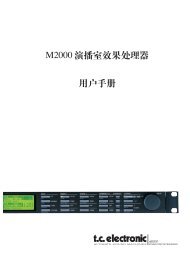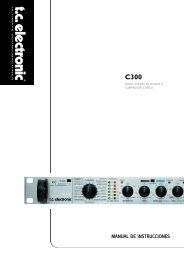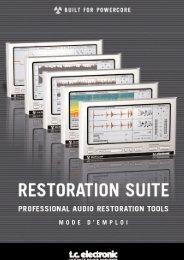EQ Station Manual v. 2.01 sw. 220 English - TC Electronic
EQ Station Manual v. 2.01 sw. 220 English - TC Electronic
EQ Station Manual v. 2.01 sw. 220 English - TC Electronic
You also want an ePaper? Increase the reach of your titles
YUMPU automatically turns print PDFs into web optimized ePapers that Google loves.
EDIT CONTROL<br />
Show Preset Name<br />
On/ Off - Sets whether the preset name should be<br />
displayed in the edit screens (Channel/Param <strong>EQ</strong>/Graph<br />
<strong>EQ</strong>/Dyn<strong>EQ</strong>). Show preset name is set to “On” as default<br />
but you may prefer to use the “Off” setting if you never use<br />
presets and thereby get a “cleaner” look on the Edit pages.<br />
Graph<strong>EQ</strong> graph:<br />
It is possible to view the Graphic <strong>EQ</strong> settings either as<br />
Bars, Curve or Bars & Curve<br />
see page 23 for examples<br />
Graph<strong>EQ</strong> width<br />
Via the menu point “Graph<strong>EQ</strong> width”you can assign which<br />
of the following three functions should be assigned to the<br />
BANDWIDTH knob:<br />
- Frequency: The function of the FR<strong>EQ</strong>UENCY knob is<br />
duplicated to the BANDWIDTH knob.<br />
Framerate<br />
Via the Channel page a delay per channel can be set. The<br />
Delay time is shown on the channel page in ms, feet,<br />
meters and frames. The Framerate should be set<br />
according to the connected devices.<br />
LCD Light & LED Light<br />
The display and the LEDs on the <strong>EQ</strong> <strong>Station</strong> are very<br />
powerful. This you will enjoy especially at outdoor usage.<br />
However, you may find the light too powerful when<br />
operating e.g. in an indoor theater setup. Therefore the<br />
LCD and LED lights can be dimmed individually.<br />
ALL - Graphic <strong>EQ</strong><br />
- Sweep: Set a Gain and <strong>sw</strong>eep this gain setting<br />
through the frequencies using the the BANDWIDTH knob.<br />
- Width: - Select width-mode and use the BANDWIDTH<br />
encoder to select more than one frequency and cut or<br />
boost the frequencies using the GAIN button.<br />
- Curve: - Select curve-mode and use the BANDWIDTH<br />
encoder to select more than one frequency. Cut and boost<br />
frequencies in curves. +/-3dB peer 1/3 oct.<br />
- Mirror: - Select mirror-mode and use the BANDWIDTH<br />
and the GAIN encoder to mirror frequencies in O dB.<br />
The ALL function is only affecting the Graphic <strong>EQ</strong> part of<br />
the processing. When activated, changes on the Graphic<br />
<strong>EQ</strong> will be done on ALL the <strong>EQ</strong> channels in the machine.<br />
When in a network, up to all 64 channels will be selected<br />
and adjusted.<br />
When entering the page a flat filter setting is displayed.<br />
Changes in the Gain setting will be applied to all channels<br />
relatively to their current state. E.g. if a channel is set to<br />
-3dB at 250Hz and 250Hz is moved to +2dB at the ALL<br />
display, the new actual setting will be -1dB for the channel.<br />
The changes on the ALL display are remembered until<br />
power down, or until the Reset button is pressed and<br />
confirmed using OK. When a reset is performed, the<br />
display filter settings will be flattened, but without<br />
performing changes on the other <strong>EQ</strong> channels settings.<br />
35




